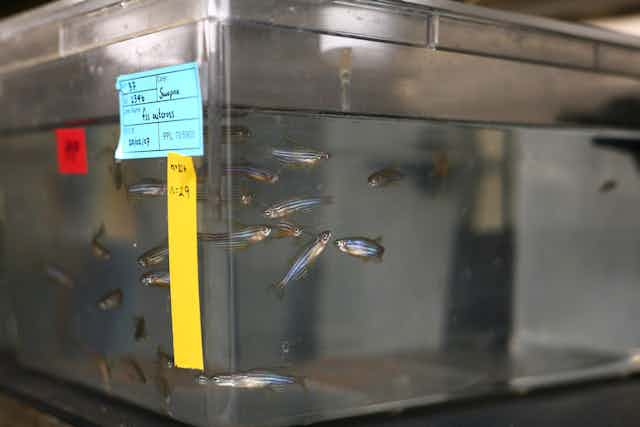In his recent article on The Conversation, Andrew Knight argues that “the overwhelming majority of invasive animal experiments do not pass the cost-benefit test required by regulations and expected by society”. This claim is based on his reviews of the scientific literature, a 2011 report on non-human primate research in the UK and alleged bias among ethics committees. The implication would seem to be that society should drastically reduce the amount of animal-based research scientists are permitted to carry out.
Knight states that the best available evidence regarding the efficacy of animal research is found in systematic reviews, especially his 2007 review. It would take quite some space to refute his paper in detail, so we will instead address a couple of the more substantial problems.
The largest flaw is probably Knight’s apparent misunderstanding of the purpose of most biomedical research – to discover knowledge rather than necessarily generating immediate clinical results. He repeatedly argues, citing papers of varying quality, that only a small proportion of animal experiments result in advancements in healthcare. But the majority of experiments using animals seek to answer questions regarding physiological processes, some of which may lead to clinical advances, rather than try to treat disease. The findings from these experiments underlie the large body of knowledge that is required for the design of experiments that directly address a clinical issue.
Knight also seems to underestimate the value of emerging technologies, such as genetically altered animal models. This new but important component of animal research only warrants a paragraph:
Genetic modification of animal models … is being attempted, to make them more closely model humans. However, as well as being technically very difficult to achieve, such modification may not allow clear conclusions due to a large variety of factors, including those reflecting the intrinsic complexity of living organisms, such as the variable redundancy of some metabolic pathways between species. Furthermore, the animal welfare burdens incurred during the creation and utilisation of genetically modified animals are particularly high.
While certainly technically challenging, these new techniques are leading to great advances not touched upon by Knight. One of his citations in this quote is actually is an excellent account of the emerging importance of transgenic animal models for biomedical research. It notes the limitations, but also concludes that they are highly useful. Many other such advances have improved the quality of animal models, including optogenetics, which allows researchers to precisely manipulate activity in nerve cells, providing exciting new avenues for research into many disorders including psychiatric conditions.

The general issue with using systematic reviews to determine the value of animal research is that they are tackling far too large a topic. Animal research involves the use of dozens of species, hundreds of techniques and addresses thousands of hypotheses. Attempting to treat the topic in a unified manner is akin to asking whether computer models are worthwhile research tools – too broad a question to usefully consider in the context of all biomedical research. Instead, scientists should (and do) ask whether animal models are useful in answering specific questions or characterising specific biological systems, such as a review of non-human primate (NHPs) of Parkinson’s Disease.
Knight also refers to the 2011 Bateson report on the use of NHPs in research, quoting:
In most cases […] little direct evidence was available of actual medical benefit in the form of changes in clinical practice or new treatments.
He neglects, however, to continue the quote:
…This dearth might have been because no link with medicine existed. However, the time that elapsed between the research and the review may have been too short for a move to practical applications to be seen.
This highlights an important issue with all research – the delay between fundamental investigation and practical application may be many years or decades. Expecting scientists to be able to convert basic research into treatments overnight is naïve, whether one is considering animal models or any other technique.
The Bateson Report actually presents a far more balanced view of animal research than Knight’s selective quote suggests. In reality, it offers both criticism and praise for work undertaken on NHPs, providing suggestions for improvements that research funding bodies are taking on board.
Similar suggestions are found in other reports assessing the value of biomedical research on animals, including the 2006 Weatherall report, 2005 Nuffield Council on Bioethics report and 2003 Animal Procedures Committeereport. The latter notes:
The case that animal experiments can produce scientifically valid results is clear, strong and sustainable, but cannot be construed as an absolute case that every potential use of animals is scientifically valid and fail safe.
No research methodology is fail-safe. By its very nature, research involves a degree of uncertainty, and research involving animals is no exception. Despite Knight’s grandiose claim that “the overwhelming majority of invasive animal experiments do not pass the cost-benefit test required by regulations and expected by society”, the reports and studies we have referred to clearly state that animal models hold substantial value.
Along with most of those arguing in opposition to animal research, Knight has failed to provide any alternative to the myriad applications for living organisms in biomedical research. Replacement of animal models is a valuable process, and indeed, when it is possible to do so, it is an ethical and legal requirement in the UK. But it is a very gradual process. It is possible that some day in the future, it will be realistic to end all animal-based research but for now it remains an essential tool, along with non-animal methods, for advancing biomedical science.

